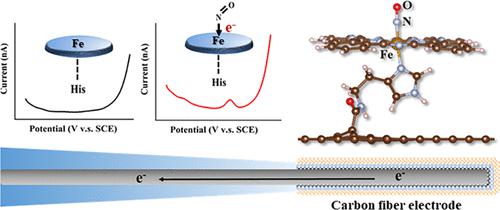当前位置:
X-MOL 学术
›
Anal. Chem.
›
论文详情
Our official English website, www.x-mol.net, welcomes your feedback! (Note: you will need to create a separate account there.)
Bio-Inspired Electrochemical Detection of Nitric Oxide Promoted by Coordinating the Histamine-Iron Phthalocyanine Catalytic Center on Microelectrode
Analytical Chemistry ( IF 7.4 ) Pub Date : 2023-05-31 , DOI: 10.1021/acs.analchem.3c00299 Jiarong Guo 1, 2 , Mingyue Li 1 , Shipeng Long 1 , Jin Zhu 1 , Peng Miao 2 , Tianxiang Wei 3 , Tao Gao 1
Analytical Chemistry ( IF 7.4 ) Pub Date : 2023-05-31 , DOI: 10.1021/acs.analchem.3c00299 Jiarong Guo 1, 2 , Mingyue Li 1 , Shipeng Long 1 , Jin Zhu 1 , Peng Miao 2 , Tianxiang Wei 3 , Tao Gao 1
Affiliation

|
Biomimetic structures to fabricate bioelectronic interfaces that allow sensors to electrically communicate with electrodes have potential applications in the development of biosensors. Herein, inspired by the structure feature of nitric oxide (NO) sensory protein, we constructed a biomimetically catalytic center, the histamine coordinated iron phthalocyanine (FePc), for efficient and sensitive detection of NO. In specific, NO is recognized by axial tethered FePc, and the oxidative signal of NO on FePc is converted into output signal through electrocatalytic oxidation. Based on the fabricated catalytic structure on the carbon fiber electrode, on one hand, the macrocyclic π system of FePc enabled a rapid redox process, which facilitates electron transfer, thereby greatly improving sensitivity. On the other hand, by coordination with histamine on the electrode surface, FePc can enhance the electrochemical oxidation activity toward NO and promote catalytic detection, which have been revealed by electrochemical characterizations and density functional theory theoretical calculations. The designed electrochemical microsensor exhibits a low limit of detection (0.03 nM) and shows a wide detection range (0.1 nM–2 μM). In addition, the electrochemical microsensor has been successfully used for real-time monitoring of NO release by live cells. So, this work shows a new strategy for the design of bio-inspired electrochemical microsensors that may provide a potential analytical tool for tracing biological signal molecules with enzyme-free biomimetically catalytic centers.
中文翻译:

微电极上配位组胺-酞菁铁催化中心促进仿生电化学检测一氧化氮
用于制造允许传感器与电极进行电气通信的生物电子接口的仿生结构在生物传感器的开发中具有潜在的应用。在此,受一氧化氮 (NO) 感觉蛋白结构特征的启发,我们构建了一个仿生催化中心,组胺配位铁酞菁 (FePc),用于高效、灵敏地检测 NO。具体而言,NO被轴向束缚的FePc识别,并且NO在FePc上的氧化信号通过电催化氧化转化为输出信号。基于在碳纤维电极上制造的催化结构,一方面,FePc 的大环 π 系统能够实现快速氧化还原过程,促进电子转移,从而大大提高灵敏度。另一方面,通过与电极表面的组胺配位,FePc可以增强对NO的电化学氧化活性,促进催化检测,电化学表征和密度泛函理论计算都揭示了这一点。设计的电化学微传感器具有低检测限 (0.03 nM) 和宽检测范围 (0.1 nM–2 μM)。此外,电化学微传感器已成功用于实时监测活细胞释放的 NO。因此,这项工作展示了一种设计受生物启发的电化学微传感器的新策略,它可以提供一种潜在的分析工具,用于追踪具有无酶仿生催化中心的生物信号分子。FePc可以增强对NO的电化学氧化活性,促进催化检测,电化学表征和密度泛函理论计算都揭示了这一点。设计的电化学微传感器具有低检测限 (0.03 nM) 和宽检测范围 (0.1 nM–2 μM)。此外,电化学微传感器已成功用于实时监测活细胞释放的 NO。因此,这项工作展示了一种设计受生物启发的电化学微传感器的新策略,它可以提供一种潜在的分析工具,用于追踪具有无酶仿生催化中心的生物信号分子。FePc可以增强对NO的电化学氧化活性,促进催化检测,电化学表征和密度泛函理论计算都揭示了这一点。设计的电化学微传感器具有低检测限 (0.03 nM) 和宽检测范围 (0.1 nM–2 μM)。此外,电化学微传感器已成功用于实时监测活细胞释放的 NO。因此,这项工作展示了一种设计受生物启发的电化学微传感器的新策略,它可以提供一种潜在的分析工具,用于追踪具有无酶仿生催化中心的生物信号分子。设计的电化学微传感器具有低检测限 (0.03 nM) 和宽检测范围 (0.1 nM–2 μM)。此外,电化学微传感器已成功用于实时监测活细胞释放的 NO。因此,这项工作展示了一种设计受生物启发的电化学微传感器的新策略,它可以提供一种潜在的分析工具,用于追踪具有无酶仿生催化中心的生物信号分子。设计的电化学微传感器具有低检测限 (0.03 nM) 和宽检测范围 (0.1 nM–2 μM)。此外,电化学微传感器已成功用于实时监测活细胞释放的 NO。因此,这项工作展示了一种设计受生物启发的电化学微传感器的新策略,它可以提供一种潜在的分析工具,用于追踪具有无酶仿生催化中心的生物信号分子。
更新日期:2023-05-31
中文翻译:

微电极上配位组胺-酞菁铁催化中心促进仿生电化学检测一氧化氮
用于制造允许传感器与电极进行电气通信的生物电子接口的仿生结构在生物传感器的开发中具有潜在的应用。在此,受一氧化氮 (NO) 感觉蛋白结构特征的启发,我们构建了一个仿生催化中心,组胺配位铁酞菁 (FePc),用于高效、灵敏地检测 NO。具体而言,NO被轴向束缚的FePc识别,并且NO在FePc上的氧化信号通过电催化氧化转化为输出信号。基于在碳纤维电极上制造的催化结构,一方面,FePc 的大环 π 系统能够实现快速氧化还原过程,促进电子转移,从而大大提高灵敏度。另一方面,通过与电极表面的组胺配位,FePc可以增强对NO的电化学氧化活性,促进催化检测,电化学表征和密度泛函理论计算都揭示了这一点。设计的电化学微传感器具有低检测限 (0.03 nM) 和宽检测范围 (0.1 nM–2 μM)。此外,电化学微传感器已成功用于实时监测活细胞释放的 NO。因此,这项工作展示了一种设计受生物启发的电化学微传感器的新策略,它可以提供一种潜在的分析工具,用于追踪具有无酶仿生催化中心的生物信号分子。FePc可以增强对NO的电化学氧化活性,促进催化检测,电化学表征和密度泛函理论计算都揭示了这一点。设计的电化学微传感器具有低检测限 (0.03 nM) 和宽检测范围 (0.1 nM–2 μM)。此外,电化学微传感器已成功用于实时监测活细胞释放的 NO。因此,这项工作展示了一种设计受生物启发的电化学微传感器的新策略,它可以提供一种潜在的分析工具,用于追踪具有无酶仿生催化中心的生物信号分子。FePc可以增强对NO的电化学氧化活性,促进催化检测,电化学表征和密度泛函理论计算都揭示了这一点。设计的电化学微传感器具有低检测限 (0.03 nM) 和宽检测范围 (0.1 nM–2 μM)。此外,电化学微传感器已成功用于实时监测活细胞释放的 NO。因此,这项工作展示了一种设计受生物启发的电化学微传感器的新策略,它可以提供一种潜在的分析工具,用于追踪具有无酶仿生催化中心的生物信号分子。设计的电化学微传感器具有低检测限 (0.03 nM) 和宽检测范围 (0.1 nM–2 μM)。此外,电化学微传感器已成功用于实时监测活细胞释放的 NO。因此,这项工作展示了一种设计受生物启发的电化学微传感器的新策略,它可以提供一种潜在的分析工具,用于追踪具有无酶仿生催化中心的生物信号分子。设计的电化学微传感器具有低检测限 (0.03 nM) 和宽检测范围 (0.1 nM–2 μM)。此外,电化学微传感器已成功用于实时监测活细胞释放的 NO。因此,这项工作展示了一种设计受生物启发的电化学微传感器的新策略,它可以提供一种潜在的分析工具,用于追踪具有无酶仿生催化中心的生物信号分子。



























 京公网安备 11010802027423号
京公网安备 11010802027423号